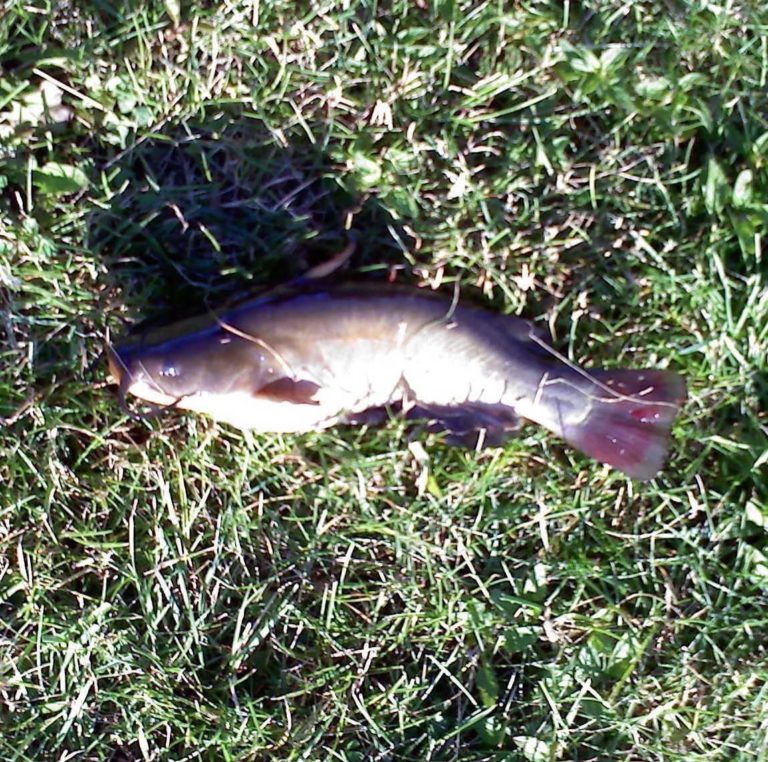The Brown Bullhead

The brown bullhead (Ameiurus nebulosus) is a type of catfish found throughout western New York. Brown bullhead typically range between 9 and 14 inches in length and can be identified by their wide mouths, barbels (whiskers), smooth skin, brown body, and general catfish appearance. The underside of the brown bullhead is typically light colored or white. Like many catfish, the brown bullhead has a sharp spine in each of its pectoral and dorsal fins that can puncture the skin if the fish is not grasped properly. However, a bullhead’s barbels do not sting! They are used for sensing.
Along with brown bullhead, yellow and black bullhead are also found in western New York. Brown bullhead are the most common, with yellow bullhead fairly common as well. Black bullhead are much harder to come by than brown or yellow bullhead. Brown bullhead can be distinguished from yellow bullhead by the color of their chin barbels. Brown bullhead will have brown or brown and white multicolored chin barbels, while a yellow bullhead’s chin barbels are usually completely white. Also, yellow bullhead typically have a lighter, yellow-brown colored body, while brown bullhead have a darker brown body. All bullhead can be distinguished from channel catfish by the shape of their tail. All bullhead have a flat tail fin, while channel catfish have a forked tail fin.
Habitat
Brown bullhead are warm-water fish and can tolerate some of the most trying conditions. Brown bullhead can tolerate excessively warm, turbid water with low oxygen levels. Given their adaptability, brown bullhead can be found in many bodies of water and typically inhabit ponds, lakes, and the deep, sluggish parts of warm-water rivers. The only place where brown bullhead are usually not found is in cold, clean, well-oxygenated wild trout streams.
In lakes and ponds, brown bullhead typically occupy weedy areas closer to shore. However, they can also be found beyond the weed edges or even in the middle of small ponds. Bullhead also like structure, and will occupy areas around downed trees, rock piles, or bridge pilings. Bullhead usually reside close to the bottom and generally do not cruise the water column or feed topwater.
Food
A bullhead’s diet consists of a variety of things, and they appear to be rather opportunistic. Bullhead will eat worms, minnows, or other small fish especially if they are dead. Bullhead will also eat crayfish if they are available. Bullhead probably feed by scavenging the lake bottom to find a meal that doesn’t require much effort, but this is not to say bullhead won’t snap up a minnow that ventures too close to its wide, powerful mouth.
Where to Catch Brown Bullhead
Brown bullhead are very common and are available in all counties of western New York. Brown bullhead are usually stocked in ponds and lakes in neighborhoods and public parks. Even ponds that aren’t stocked can have a population of naturally reproducing bullhead. For this reason, local ponds and lakes are usually the best place to target brown bullhead.
The best time of year to target bullhead is the spring in April through June, but they can easily be caught all through summer and into fall. The best time of day to target bullhead is dusk, especially in the summer. At local ponds and lakes, the bullhead bite usually begins just after the sun has set behind the horizon and lasts a couple hours thereafter.
How to Catch Bullhead
Bullhead are usually caught on live bait, including worms, minnows, and even corn. The best way to target brown bullhead is probably a nice piece of nightcrawler fished on the bottom. A good rig consists of a hook, piece of nightcrawler, and a small split shot fished without a bobber.
When targeting bullhead, cast your rig out and allow it to sink to the bottom and reel in any slack so that your line is tight. Allow your bait to sit for a while, giving it a couple short jerks every now and then to make sure your rig isn’t cobbed up in the weeds. Bullhead takes can be very subtle, and for this reason, you should make sure line is tight so that you don’t allow bullhead to run with your line for too long and swallow the hook.
